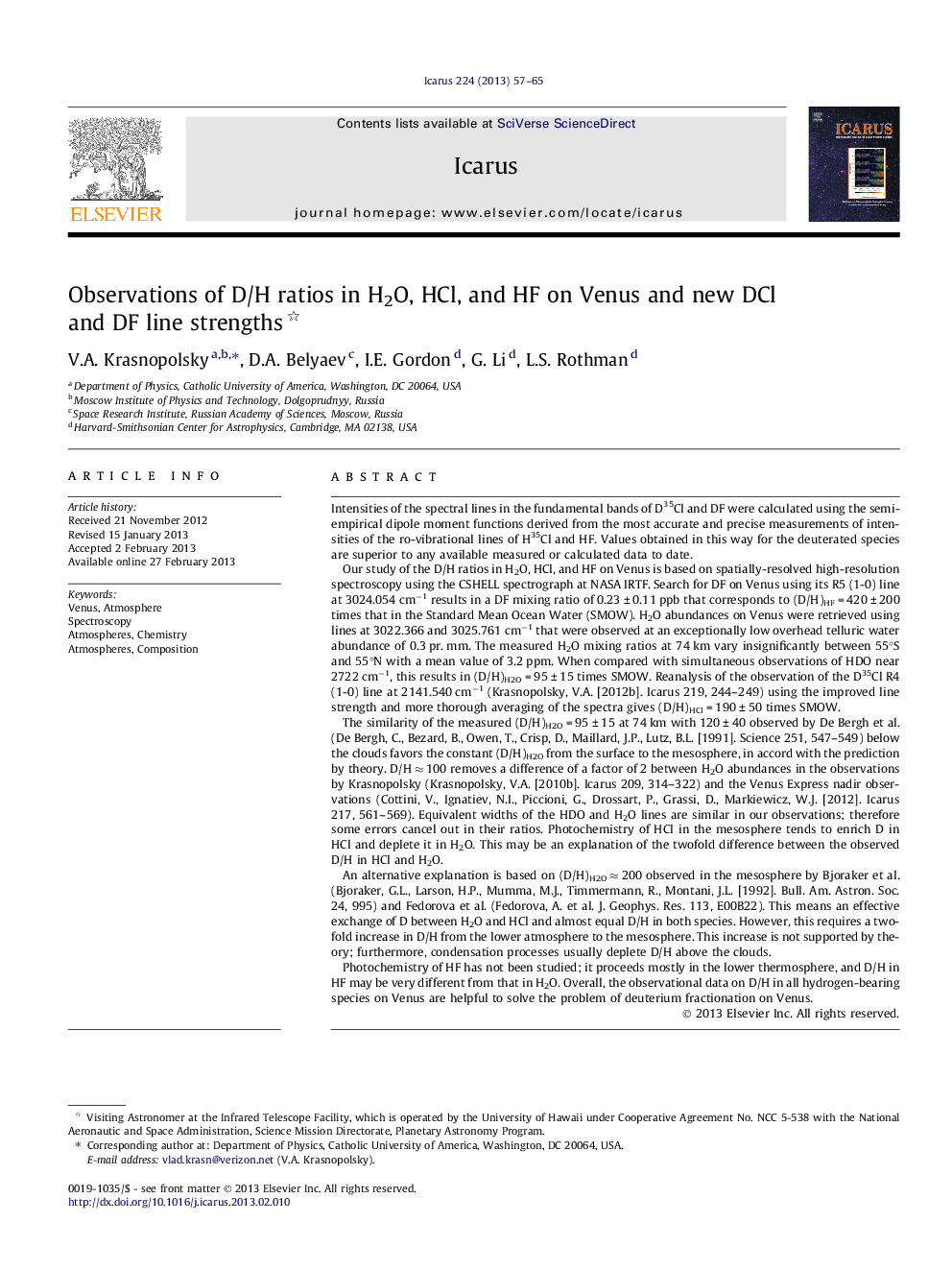| Article ID | Journal | Published Year | Pages | File Type |
|---|---|---|---|---|
| 1773529 | Icarus | 2013 | 9 Pages |
Intensities of the spectral lines in the fundamental bands of D35Cl and DF were calculated using the semi-empirical dipole moment functions derived from the most accurate and precise measurements of intensities of the ro-vibrational lines of H35Cl and HF. Values obtained in this way for the deuterated species are superior to any available measured or calculated data to date.Our study of the D/H ratios in H2O, HCl, and HF on Venus is based on spatially-resolved high-resolution spectroscopy using the CSHELL spectrograph at NASA IRTF. Search for DF on Venus using its R5 (1-0) line at 3024.054 cm−1 results in a DF mixing ratio of 0.23 ± 0.11 ppb that corresponds to (D/H)HF = 420 ± 200 times that in the Standard Mean Ocean Water (SMOW). H2O abundances on Venus were retrieved using lines at 3022.366 and 3025.761 cm−1 that were observed at an exceptionally low overhead telluric water abundance of 0.3 pr. mm. The measured H2O mixing ratios at 74 km vary insignificantly between 55°S and 55°N with a mean value of 3.2 ppm. When compared with simultaneous observations of HDO near 2722 cm−1, this results in (D/H)H2O = 95 ± 15 times SMOW. Reanalysis of the observation of the D35Cl R4 (1-0) line at 2141.540 cm−1 (Krasnopolsky, V.A. [2012b]. Icarus 219, 244–249) using the improved line strength and more thorough averaging of the spectra gives (D/H)HCl = 190 ± 50 times SMOW.The similarity of the measured (D/H)H2O = 95 ± 15 at 74 km with 120 ± 40 observed by De Bergh et al. (De Bergh, C., Bezard, B., Owen, T., Crisp, D., Maillard, J.P., Lutz, B.L. [1991]. Science 251, 547–549) below the clouds favors the constant (D/H)H2O from the surface to the mesosphere, in accord with the prediction by theory. D/H ≈ 100 removes a difference of a factor of 2 between H2O abundances in the observations by Krasnopolsky (Krasnopolsky, V.A. [2010b]. Icarus 209, 314–322) and the Venus Express nadir observations (Cottini, V., Ignatiev, N.I., Piccioni, G., Drossart, P., Grassi, D., Markiewicz, W.J. [2012]. Icarus 217, 561–569). Equivalent widths of the HDO and H2O lines are similar in our observations; therefore some errors cancel out in their ratios. Photochemistry of HCl in the mesosphere tends to enrich D in HCl and deplete it in H2O. This may be an explanation of the twofold difference between the observed D/H in HCl and H2O.An alternative explanation is based on (D/H)H2O ≈ 200 observed in the mesosphere by Bjoraker et al. (Bjoraker, G.L., Larson, H.P., Mumma, M.J., Timmermann, R., Montani, J.L. [1992]. Bull. Am. Astron. Soc. 24, 995) and Fedorova et al. (Fedorova, A. et al. J. Geophys. Res. 113, E00B22). This means an effective exchange of D between H2O and HCl and almost equal D/H in both species. However, this requires a twofold increase in D/H from the lower atmosphere to the mesosphere. This increase is not supported by theory; furthermore, condensation processes usually deplete D/H above the clouds.Photochemistry of HF has not been studied; it proceeds mostly in the lower thermosphere, and D/H in HF may be very different from that in H2O. Overall, the observational data on D/H in all hydrogen-bearing species on Venus are helpful to solve the problem of deuterium fractionation on Venus.
► New DCl and DF line lists. ► First ground-based observation of D/H in H2O above the Venus clouds. ► First observation of D/H in HF on Venus. ► Improved D/H in HCl on Venus. ► Observed D/H in water on Venus favors a constant D/H profile, in accord with theory.
